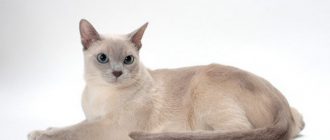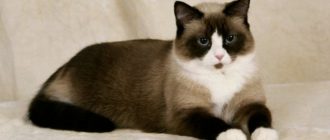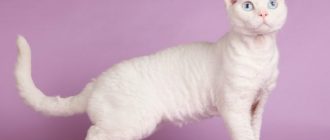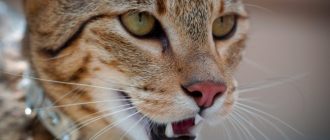Brief description of the breed
Contents
British Shorthair – one of the oldest large Great Britain cat breeds. The breed was originally known by the name is British Blue. The name was associated with a characteristic pet color. British blue was bred around the end nineteenth century. In the process of selection, the color of the animal has changed, therefore, the name has become not entirely relevant. Concerning representatives of the breed began to be called “British short-haired. “Today there are more than a hundred Variations of color and pattern of these cats. Officially British a short-haired cat is described as a strong pet, with a strong, stocky body, short legs, round head, small, wide-set ears and short straight nose. Short hair, similar to plush with a characteristic undercoat helps the animal keep warm well on cool days. The color of the coat and variations the patterns of this breed are the richest. Hair can have almost any shade: white, black, blue, red, cream, chocolate, lilac. There may be cats whose hair has two-color or three-color color. Eye color can be different. It will depend on the coat color of the animal. Many people think that British Shorthair cats have the most gorgeous eye color white color. These pets have deep sapphire eyes. Eyes can also be dark gold, copper or orange. colors. It is noteworthy that among the representatives of the breed quite animals with colorful eyes are often found.
Photo of a British Shorthair cat:
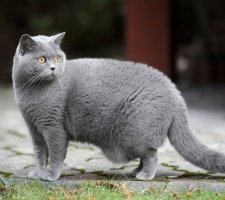

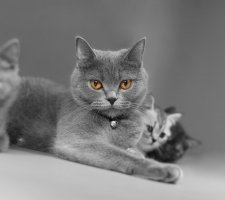



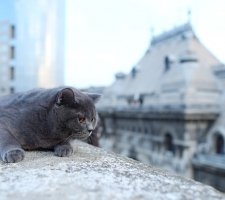

 Pictures of Dog Breeds |
Pictures of Dog Breeds |
History of the British Shorthair
The breed was bred in the nineteenth century. She almost immediately caught on among British home lovers animals. They could be found in many houses, on farms and just outside. The appearance of the breed on foggy Albion is associated with the invasion of the Roman conquerors, who brought the ancestors to territory of the kingdom. It is believed that initially the breed appeared thanks to the crossbreeding of local animals with European cats species characterized by strong musculature. At the exhibition, held at the British Crystal Palace in 1871, the British Shorthair has become the most popular breed. While representatives of this breed were considered the most fashionable cats Britain. However, at the turn of the nineteenth and twentieth centuries, the breed started to decline. In the late 1800s, early 1900s almost no one is breeding a british shorthair was engaged. As a result, the number of breed representatives became rapidly decline. By the beginning of the fifties of the past century, the breed has almost disappeared. It was also connected with the emergence of new breeds of cats that interested most breeders, and the British Shorthair didn’t even go to second, and to the third plan. The situation was saved by a group of breeders who decided take measures to preserve the breed. Unfortunately, selection by crossing purebred representatives of the breed because of their small quantity has become virtually impossible. The decision was made cross existing british shorthair with cats Persian breed, as well as with cats that look similar to Shorthair British. As a result, pets appeared, slightly different from those considered standard. Such visual differences caused a long abandonment of the official recognition of newly bred cats and ranking them as British shorthair. But a few years later, nevertheless, these animals were ranked as representatives of the breed. A new stage of development has begun British Shorthair cats.
Character of a british shorthair cat
The British Shorthair is often described as calm and an unobtrusive animal with a fairly independent character. Despite this, representatives of the breed adore being among family members and participate in all family events. Not to say that the Shorthair British are affectionate pets. It should be noted that these cats are very selective. Unlike many other breeds, this cat will not go on hand to the first comer, also the pet is unlikely to be happy chatting with strangers. The cat loves to sit on the hands of only those the people she chose herself. The British Shorthair is not very demanding of herself in terms of care and attention. Concerning it is considered to be a great option for busy people who most of the time spent at work. These cats are worth it will appreciate the company of another pet if they stay alone at home for a long time. Despite such an extraordinary character, Shorthair British are quite tolerant of children. Kittens of this breeds, like most young animals of other breeds, are playful and active, but in the process of growing up they become less mobile, instead of active games more and more often choosing the ability to just lie around or take a nap. Even being alone for a long time, short-haired the british cat is not very active, so your furniture or decor items are unlikely to be affected.
Maintenance and care
The british shorthair cats are quite short, so will not cause much trouble. For normal care will be enough remove excess hair with a soft brush or just plain stroking. Weekly monitoring of ear condition and make sure that they do not cause inflammation, irritation or pollution. The ears are treated with a special solution, which is appointed by the veterinarian.
Feeding
In principle, British Shorthair cats are not particularly picky. They will gladly eat specialized dry and canned food. In this case, do not forget about the need the systematic addition of boiled chicken to the pet’s diet, ham, cheese. Due to the fact that cats of this breed are mainly lead a passive lifestyle, care should be taken that the pet did not gain weight. Otherwise, the animal may threaten obesity. This problem is especially relevant for neutered cats. Experts argue that Shorthair British cat per day must receive 70 kilocalories per 1 kilogram of weight. It should be understood that certain foods should not be included in the diet of the animal. For example, a cow milk, which can cause indigestion.
Health and Disease
The British Shorthair is a very old breed. She was displayed on foggy Albion, so her body, and therefore health, genetically designed for the climatic conditions of Britain. In a different climate, animals may show certain ailments. Infectious and colds. Fortunately, other health problems unlikely. To prevent infectious problems, you should conduct timely vaccination of the animal.

